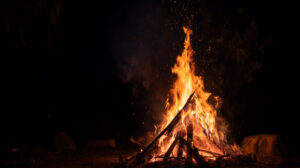Sefirah? What’s Sefirah?

T
he Pesach Yom Tov we recently celebrated afforded me the opportunity to daven Shacharis on Chol Hamoed in the shul of the Bostoner Rebbe shlita. I was an occasional mispallel there after my family moved to Brighton when I was all of seven years old. Looking around the shul I waxed nostalgic, taking in the sights: the same benches I had sat on more than half a century ago, the social hall where I bested a bochur a number of years my senior at the Pirchei table-hockey championships, and, of course, the matzah bakery where my father and the previous Rebbe zichronam livrachah baked matzos on Erev Pesach. Then, I took a long, hard stare at a plaque above the chazzan’s amud that, when I was a young child, seemed to be the most puzzling thing I had ever read. The simple marble slab reads, “In sacred remembrance of our six million brethren who were murdered during the Holocaust 1939–1945. Eretz al techasi damam.”
Gazing at this plaque brought back the memory of the first time I, a child of Holocaust survivors, saw it and wondered what it meant. Six million were murdered. Where? How? By whom? Holocaust? What’s a Holocaust?
I came home from shul and asked my mother what this was all about. Sure, I had heard about “the war” in the course of various conversations my mother had with her siblings — who had also established families, b’chasdei Hashem, in our neighborhood — as well as with my siblings and me. It was some mystical, otherworldly term that really had no concrete meaning to me. Until I saw the plaque. I still couldn’t comprehend the little bits of information I had heard, but now I knew it was bad, really bad.
Incredibly, conversation about this topic was uncommon when we were growing up. Many heroes of the she’eiris hapleitah chose to move forward and build new lives, leaving the horrors of their past behind them. Their children would be spared the graphic details, and would have the ability to lead blissfully innocent lives, such as mine.
As an adult blessed with children of my own, I stared at the hallowed plaque with renewed interest. I read it slowly, 1939–1945. This was barely 20 years prior to my first encounter with the plaque, and yet I had been totally ignorant. How could that be? How does such an indescribably horrific tragedy remain so secret only a short time after it occurred? Weren’t everyone’s lives forever altered by it? Yet so it was. And for many of the she’eiris hapleitah, it was by design. It would remain their tragedy until they were ready to share it.
Which brings us to the Yemei HaSefirah. We are all very familiar with the customs of aveilus that were instituted, and codified in the Shulchan Aruch, due to the deaths of 24,000 disciples of Rabi Akiva between Pesach and Shavuos. This happened much more than 20 years ago; it took place close to 2,000 years ago. Yet we are still required to remember and mourn this tragedy.
Let us give it some modern perspective. Imagine a gadol in our time had trained 24,000 talmidim in everything he stood for and was able to share with the entire Klal Yisrael, and suddenly in the course of seven weeks, they would all be taken from us. Would we not be paralyzed by the aveilus of such a tragedy, the likes of which we could never overcome?
Returning to the 24,000 talmidim, who, the Gemara tells us, were guilty of not according proper kavod to one another. These were talmidim of the great Tanna Rabi Akiva, the one Moshe Rabbeinu said was more fit to receive the Torah than even he himself. Can we imagine how the world would have been forever altered had they merited to live? How many more Torah teachings would we have had! How much more clarity in hashkafah could we have gained!
We have been enjoined to think about this tragedy during every Sefirah period for thousands of years, and to improve our own kavod for others so that we may merit kabbalas haTorah. In one of the most widely quoted sichos of Rav Aharon Kotler ztz”l, he explains that in order to merit transmitting Torah to the next generation, a talmid chacham must perfect himself in the 48 attributes delineated in the Mishnah in Avos that are the prerequisites for kinyan Torah. Rabi Akiva’s talmidim, at the level on which they were judged, failed to meet that standard. Had they succeeded, we can only imagine how the entire world of Torah would have been forever changed. This was a tragedy of enormous proportions that we must not forget, and for which it is fitting to retain some minor practices of mourning even thousands of years later. Chazal wanted us to remember, so they created reminders.
I find it quite disconcerting and disturbing, then, when the inevitable annual phone calls come in asking for various heterim during Sefirah. More than once I have asked questioners if they know why we refrain from listening to music during Sefirah. The standard answer is something about Rabi Akiva’s talmidim. But the conversation cannot end there. I will prod them further and ask, “Who cares? It was so long ago,” and use that as a springboard for a discussion about what we lost.
To be honest, the Yemei HaSefirah today look quite different from the ones I recall as a child or even a young adult. Yes, there was a wedding here and there before Rosh Chodesh Iyar, but save for Lag B’omer, when the minhag Yisrael was to watch the rebbi try to hit a baseball off a fifth-grade flame thrower, it was a month and a half of awareness that something was different. Music was not even contemplated. The spirit of the period mattered. In our house we didn’t even buy new clothes, though this is not necessarily included in the accepted minhagim of the period. Shuls that normally davened Maariv shortly after Minchah would have longer-than-usual learning sessions with the rav so that they could count the Omer when it was halachically night. I personally recall observing in awe one night at the Bostoner Rebbe’s shul as the Rebbe led a Mishnayos shiur for much longer than usual — and everybody stayed! Weddings after Lag B’omer were unheard of, and somehow we managed to survive for a few weeks without our cassettes and eight-tracks. The expression “Nu, Sefirah!” automatically brought us back to reality if we so much as contemplated anything that may have been perceived as an affront to the mood of this period.
Fast-forward to today. Baruch Hashem, there are many more Yidden in America than there were then, and certainly many more anshei shlomeinu who adhere to the Torah and abide by all of Chazal’s instructions. As our numbers increase, kein yirbu, so does the number of weddings and simchahs. Venues have become increasingly difficult to secure, and long engagements are avoided. Weddings before Rosh Chodesh Iyar have become common, as halachah certainly allows. And the night of Lag B’omer has been pressed into emergency service as well (Rav Moshe Feinstein ztz”l wrote a teshuvah permitting this under difficult circumstances). As of late, we even hear of weddings after Lag B’omer. Certainly, sh’eilos are asked and daas Torah is consulted. But what are we left with? How common are Minchah-Maariv minyanim with a longer Mishnayos shiur?
On the other hand, how many people manage to get their music “fix” through a cappella, marveling that “It mamash sounds like the real thing!” (The halachic status of a cappella is not a discussion for this forum, although I have heard at least one renowned posek describe it with the term “naval birshus haTorah.” I personally have a problem with the “reshus” part, as the idea was to limit our simchah by avoiding dancing and the types of things that might bring one to dance. I doubt that those who instituted these restrictions would be proud of our creative loopholes.)
How many of us go about our daily lives with nary a thought that it is Sefirah at all, until the inevitable “How many was yesterday?” after tzeis hakochavim.
We are an am kadosh and have held on to our mesorah through so much trial and tribulation. We do not chas v’shalom want to see the days when our little ones look at a Sefirah counter above the amud in shul and ask us, “Sefirah? What’s Sefirah?”
Let us heighten our awareness on every front and at least hold on to what we can. Working on our nahagu kavod zeh lazeh is an avodas hazeman, but certainly not the only one. Our Sefirah beards may be admirable, but nothing matches the genuine diminishing of the spirit of “simchah as usual.” We may also want to go in the footsteps of the Vilna Gaon, who taught us that each day of Sefirah corresponds to the 48 kinyanim listed in Avos, with the 49th day reserved for reviewing them all. Focusing on “a kinyan a day” would perhaps introduce a constant awareness of this special time to our daily consciousness.
Chazal did not want the memory of this tragedy swept under the rug despite it being so long ago. They wanted us to learn from it, to grow from it, and im yirtzeh Hashem one day to merit a world where once again Torah will flourish as in days long ago.
Originally featured in Mishpacha, Issue 760. Rabbi Plotnik,a talmid of the yeshivos of Philadelphia and Ponovezh, has been active in rabbanus and chinuch for 25 years and currently serves as ram in Yeshivas Me’or HaTorah in Chicago.
Oops! We could not locate your form.













